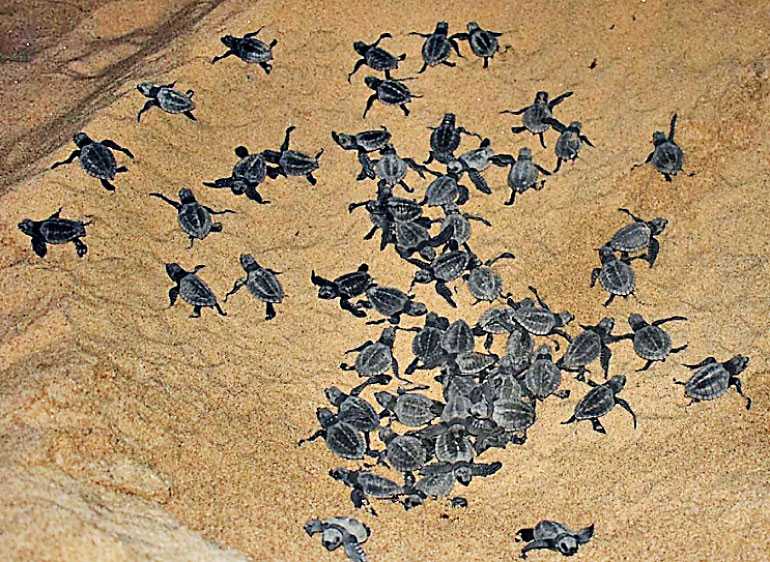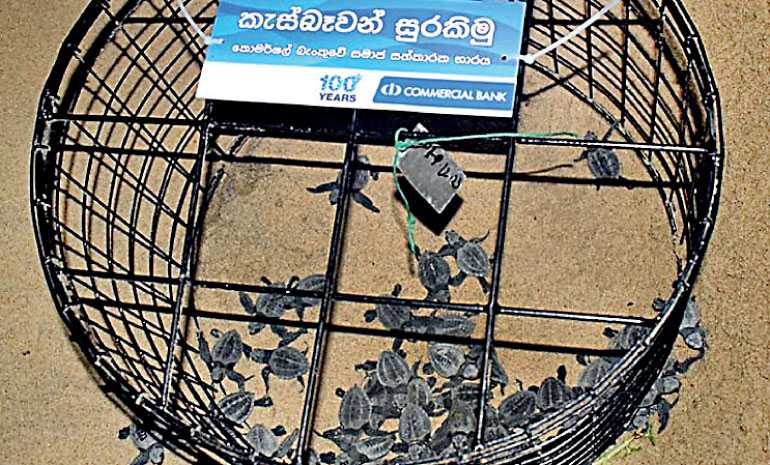Thursday Apr 25, 2024
Thursday Apr 25, 2024
Monday, 27 July 2020 00:00 - - {{hitsCtrl.values.hits}}

The Commercial Bank of Ceylon has pledged support to a marine turtle conservation project in Panama on the east coast of Sri Lanka, to enable the expansion of the scope of the project from the Kumana village to Panakala Lagoon.
The project of Wildlife and Ocean Resource Conservation (WORC) of Sri Lanka spans 3kms of previously unprotected territory that is home to four species of turtles including the Videlicet Green, Olive Ridley, Loggerhead and Leatherback turtles; that will now be included in WORC’s conservation efforts.
The immediate objective of the program is to protect the nests and eggs of these sea turtles from predators such as pigs, foxes, mongoose, spotted iguana and dogs.
Beach patrols by night and day, covering of nests with metal cages to protect them from wild animals, and training and converting egg collectors to nest protectors are some of the initiatives to be implemented to achieve the objective of the conservation program.
Collecting field data, conducting school awareness programs and field visits, monitoring turtle nests and reporting too, does fall under the scope of this project. The overall aim of the project is to restore a degraded ecosystem and inspire a culture and community of environmental stewardship.
Besides funding the project, the Bank will support WORC in its efforts to build partnerships with communities, raise awareness, and identify sustainable livelihoods and business opportunities associated with the project, and kick-start associated activities.
The Bank said it will engage actively in the project wherever possible. The financial support offered by the Bank will be used to remunerate the project coordinator and the field officials who will oversee the nest protection program, cover travel expenses, research, lodging and meals costs involved in project management, purchase of rechargeable torches and iron cages, to conduct school awareness programs, and field visits to encourage involvement of the local community.
Wildlife and Ocean Resource Conservation initiated this turtle conservation project in 2013 at the Panama beach, under the observation and instruction of Professor K.B. Ranawana and Vimukthi Veerathunga.
With financial support from supportive organisations, it fulfilled its conservation objectives which included identifying egg collectors, educating them about the importance of protecting turtles and converting them into nest protectors.
The conservation covered an area of 3km, from the Panama Lagoon mouth to Kumana Village. Since 2013, the survival rate of hatchlings and eggs has increased, from 13,564 eggs and 12,265 hatchlings in 2013 to 17,500 eggs and 15,700 hatchlings in 2018. The current conservation project under the MoU with Commercial Bank has resulted in the expansion of the protected territory by another 3km, and has to date resulted in the release of 11,000 turtles.
The conservation initiatives of WORC in Panama are important because four of the seven species of sea turtles in the world come ashore to nest in Panama. Of these, the Leatherback has only been reported once after twenty years.
While all seven species are included in the IUCN red list of threatened animals, the species of Kemp’s Ridley, Hawksbill and Leatherback are considered critically endangered, and the Loggerhead, Green Turtle and Olive Ridley are listed as endangered.
Wildlife and Ocean Resource Conservation is a not-for-profit organisation focused on conservation and ecosystem restoration in Sri Lanka. It supports community-based sea turtle conservation in Panama and Pottuvil, mangrove forest conservation and restoration in Koggala, and coral reef conservation and restoration in Rumassala.
WORC offers travel experiences in all of these areas and all income from eco-tourism is used to fund ongoing conservation and restoration work. The Commercial Bank of Ceylon also provided financial support to another WORC conservation project last year. The ‘Koggala Mangrove Restoration and Conservation Project,’ involved the planting of 2,000 mangrove plants, 750 mangrove associates and 500 terrestrial plants on ‘Kath Duwa, a little island in the Koggala Lake.
